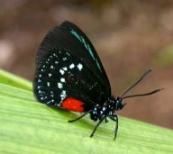Atala News March 2008
 I was the Teaching Assistant for the NSU field trip to Myakka State Park and Venice Beach for Dr. Joshua Feingold’s Marine Biology students this month; it was great! (Plus it was my birthday, so this field trip was like a birthday present!) At Upper Myakka Lake, we witnessed an adult Bald Eagle sitting on the ground for quite a while…What was it doing? What we didn’t realize, until a moment later, was that the eagle was focused on an osprey that was cruising over the water. When the osprey caught its’ fish, the eagle lifted off and chased the osprey until it released its catch of the morning. The eagle then caught the fish in mid-air, and was then immediately chased by an immature eagle until they flew out of sight—perhaps an offspring, still looking for a free meal. What can be deduced is the old maxim: No honor among thieves!
I was the Teaching Assistant for the NSU field trip to Myakka State Park and Venice Beach for Dr. Joshua Feingold’s Marine Biology students this month; it was great! (Plus it was my birthday, so this field trip was like a birthday present!) At Upper Myakka Lake, we witnessed an adult Bald Eagle sitting on the ground for quite a while…What was it doing? What we didn’t realize, until a moment later, was that the eagle was focused on an osprey that was cruising over the water. When the osprey caught its’ fish, the eagle lifted off and chased the osprey until it released its catch of the morning. The eagle then caught the fish in mid-air, and was then immediately chased by an immature eagle until they flew out of sight—perhaps an offspring, still looking for a free meal. What can be deduced is the old maxim: No honor among thieves!We also saw an adult wild boar (or sow) foraging on the opposite shore, and a turkey foraging in the grasses, as well as the ubiquitous alligators. Limpkins were searching for apple snails, and we found plenty of ‘de-snailed’ shells along the shore, proving that the limpkin was successful, and that there is a healthy snail population at Myakka. The snails were not our native apple snail species, but fortunately neither the limpkin nor the endangered Snail Kite seem to care. The ancient oaks were a main attraction to the students as well!

Sandhill Cranes were seen flying overhead, and there were plenty of Florida’s beautiful wading birds—Tri-color, Great Blue, Little Blue and Green Herons, Snowy and American Egrets, Glossy and White Iibis. Also seen: Carolina Wrens, Black and White Warblers, Red-Shouldered Hawks, Skimmers, Blue-Winged Teal ducks, Anhingas, Cormorants, Black Neck Stilts, and Wood Storks.
An interesting luncheon was observed as a small group of Black Vultures snacked on a dead Soft-Shell Turtle (Apalone ferox). That's Dr. Feingold taking close-ups of the event.

And smaller critters, too: this pretty but deadly bloodsucking “Assassin Bug” (Triatoma sanguisuga). This female Brown Anole (Anolis sagrei) stayed still long enough to snap her photo.
At Venice Beach and Manasota Beach, we saw White Pelicans, Brown Pelicans, Ruddy Turnstones, Least Sandpipers, and Short-billed Dowitchers--all in all we saw 28 species of birds in our two day adventure! But, only one butterfly to list: the Queen. The rack line provided plenty of sea shells for the students to identify, as well as shark egg cases, sponges, Gorgonian sea fans, corals, sea beans, sea weeds, amphipods, and living mollusks.
 Everyone went home happy despite the rainy weather and very long drive…because everyone went home with a small collection of shark’s teeth and intact shells from the shores famous for them…one has to wonder how many sharks there must have been at one time: for over a hundred years tourists have been collecting the teeth and yet there are still more to be found….one of Life’s many amazing mysteries!
Everyone went home happy despite the rainy weather and very long drive…because everyone went home with a small collection of shark’s teeth and intact shells from the shores famous for them…one has to wonder how many sharks there must have been at one time: for over a hundred years tourists have been collecting the teeth and yet there are still more to be found….one of Life’s many amazing mysteries! And speaking of amazing teeth: I came across this very prehistoric remnant skeleton of a Mesozoic fish, Amia calva, on the shore of the Francis Taylor Wildlife Management Area this week at work. (Thanks to Dr. Rehage for the ID!) It is the only remaining fish of an otherwise extinct genus and is also known as Mudfish and Dogfish. They are capable of breathing air when necessary, and therefore able to survive in waterways with low oxygen content. It is only found in North America, but ancient fossils have been found in Europe. From what I have read about it, fishermen warn that those teeth will bite at anything in their way, including human fingers…so beware! They seem to be more dangerous than alligators….I also found an alligator vertebra …evidence of a once-big gator. I don’t think the Mudfish had anything to do with the demise of the gator, though….. 
You never know what you’ll find in Florida’s wonderful ecosystems! There are a lot of events scheduled for April, too, so I hope you stay tuned for the news, and hope to see you at an upcoming program!

You never know what you’ll find in Florida’s wonderful ecosystems! There are a lot of events scheduled for April, too, so I hope you stay tuned for the news, and hope to see you at an upcoming program!







0 Comments:
Post a Comment
<< Home